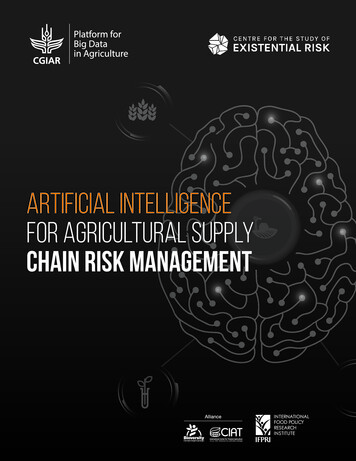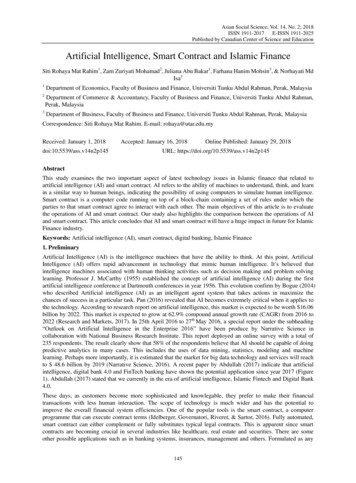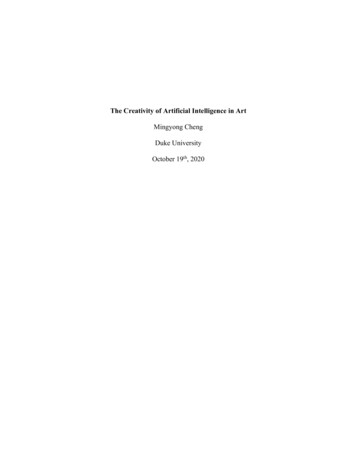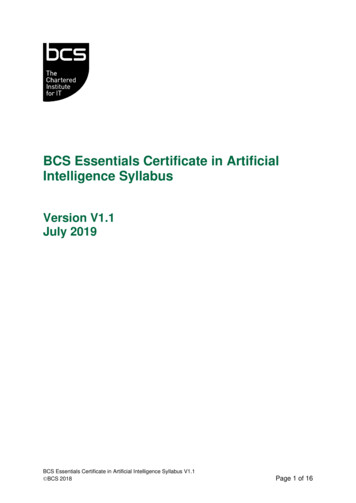
Transcription
Artificial Intelligencefor Agricultural SupplyChain Risk Management1Artificial Intelligence for Agricultural Supply Chain Risk Management
University of Cambridge, Centre for the Study of Existential RiskThe Centre for the Study of Existential Risk (CSER) is an interdisciplinary research centre within the University of Cambridgededicated to the study and mitigation of global catastrophic risks. The Centre works to understand extreme risksassociated with emerging technologies and human activity; and to develop a methodological toolkit to aid in identifyingand evaluating future extreme risks.The Centre operates in an interdisciplinary way across four main focus areas: Managing Extreme Technological Risks,Global Catastrophic Biological Risks, Extreme Risks and the Global Environment, and Risks from Artificial Intelligence.https://www.cser.ac.uk/CGIAR, Platform for Big Data in AgricultureThe CGIAR Platform for Big Data in Agriculture is a cross-cutting program of the global CGIAR consortium of non-profitresearch institutes looking into virtually every aspect of food security spanning: genomics, breeding, agroecology, climatescience, and the socioeconomic drivers and context of food systems change. The Platform tends to data standards anddata sharing, digital innovation strategy and technology transfer, and research into the intersection of digital technologiesand agricultural development in emerging regions.CGIAR is a global research partnership for a food secure future dedicated to reducing poverty, enhancing food and nutritionsecurity, and improving natural resources.https://bigdata.cgiar.org/Tzachor, Asaf (2020). Artificial Intelligence for Agricultural Supply Chain Risk Management: Constraints andPotentials., CGIAR. 27 p. Available at: https://hdl.handle.net/10568/108709About the authorDr Asaf TzachorCentre for the Study of Existential Risk, University of CambridgeGlobal Food Security Research Centre, University of CambridgeJune 2020
OPEN ACCESS RESEARCH PAPERArtificial Intelligence forAgricultural Supply ChainRisk Management:Constraints and PotentialsAsaf TzachorUniversity of Cambridge3Artificial Intelligence for Agricultural Supply Chain Risk Management
AbstractSupply chains of staple crops, in developed and developing regions, arevulnerable to an array of disturbances and disruptions. These include biotic,abiotic and institutional risk factors. Artificial intelligence (AI) systems have thepotential to mitigate some of these vulnerabilities across supply chains, andthereby improve the state of global food security.However, the particular properties of each supply chain phase, from "the farmto the fork," might suggest that some phases are more vulnerable to risks thanothers. Furthermore, the social circumstances and technological environmentof each phase may indicate that several phases of the supply chains will bemore receptive to AI adoption and deployment than others.This research paper seeks to test these assumptions to inform the integrationof AI in agricultural supply chains. It employs a supply chain risk managementapproach (SCRM) and draws on a mix-methods research design.In the qualitative component of the research, interviews are conductedwith agricultural supply chain and food security experts from the Food andAgricultural Organization of the UN (FAO), the World Bank, CGIAR, the WorldFood Program (WFP) and the University of Cambridge.In the quantitative component of the paper, seventy-two scientists andresearchers in the domains of digital agriculture, big data in agriculture andagricultural supply chains are surveyed. The survey is used to generateassessments of the vulnerability of different phases of supply chains to biotic,abiotic and institutional risks, and the ease of AI adoption and deployment inthese phases.The findings show that respondents expect the vulnerability to risks of all butone supply chain phases to increase over the next ten years.Importantly, where the integration of AI systems will be most desirable, inhighly vulnerable supply chain phases in developing countries, the potentialfor AI integration is likely to be limited.To the best of our knowledge, the methodical examination of AI throughthe prism of agricultural SCRM, drawing on expert insights, has never beenconducted. This paper carries out a first assessment of this kind and providespreliminary prioritizations to benefit agricultural SCRM as well as to guidefurther research on AI for global food security.KEYWORDSArtificial Intelligence, Agriculture, Supply ChainRisk Management, Food Security4Artificial Intelligence for Agricultural Supply Chain Risk Management
TABLE OF CONTENTS123455ABSTRACT5INTRODUCTION6METHODS AND IONSACKNOWLEDGMENTSREFERENCES212122Artificial Intelligence for Agricultural Supply Chain Risk Management
IntroductionFood security has been defined by the Food and Agricultural Organization of the UN as astate in which all people, at all times, have access to food to meet their dietary needs andpreferences.1 This state can only be sustained by the continuous production, processingand provision of nutritionally adequate, safe and affordable agricultural commodities.Therefore, global food security depends on effective, efficient and risk-resilient agriculturalfood supply chains. 2,3,4,5,6,7,8,9,10,11 That being so, agricultural supply chain risk management(SCRM) is crucial for achieving global food security.12The crux of supply chain risk management is the identification of supply chain vulnerabilities,the assessment of risks that the supply chain may be exposed to, and the actions prescribedto mitigate vulnerabilities and risks; actions referred to as either ex-ante or ex-post riskmanagement measures.13,14,15,16,17,18,19 An extensive catalogue of ex-ante and ex-post measuresis proposed in the literature to mitigate risks in agri-food supply chains. 20,21,22,23,24,25,26More recently, scientists have recognized that emerging technologies can contribute to themitigation of different types of supply chain inefficiencies, losses and risks, and to improvethe overall agri-food system’s resilience, in order to achieve global food and nutritionalsecurity. “It is essential,” note Cole et al., “to explore how innovations from [ ] data science,robotics, artificial intelligence [ ] impact on food security.” 27Of these emerging technologies and techniques, artificial intelligence (AI) systems arelikely to have significant applications for SCRM, and thereby to improve the state of globalfood security.6Artificial Intelligence for Agricultural Supply Chain Risk Management
1.1 Artificial intelligenceAI refers to a set of technologies that carry out functions that we traditionally think of as requiringhuman intelligence. They are computer systems that are used to identify objects, recognize patterns andanomalies, solve problems, allocate resources optimally, navigate, predict failures, make personalizedrecommendations, and learn.28 For certain cognitive functions, such as patterns and anomalies recognition,several AI systems can exceed human performance.29,30,31 *AI is often used to control robots, autonomously or under the direction of a human. With robotics, AI couldreplace or aid humans in routine work in industrial-scale production, in domains where manual work canbe done by robots; this is referred to as robotics process automation (RPA).1.2 Artificial intelligence in agricultural supply chainsOver the next decade, the time frame allotted to meet the second sustainable development goal of endinghunger, AI systems are expected to have the potential to benefit the global agricultural system in numerousimportant ways. They can increase crop and livestock yields, decrease food loss and waste, and allocateresources optimally. 32,33,34,35,36,37,38Several studies have outlined and illustrated these options, and AI systems and networks, in combinationwith smart sensors, communication technologies, big data sets and robotics, are already being experimentedwith and integrated in various phases of the global food chain.†Examples include detection and diagnostics of plant diseases and pests, 39,40,41,42,43 protection of aquaculturefrom bacteria,44 modelling soil physicochemical properties and composition,45 simulating and evaluatingfuture degradation of the biophysical environment emanating from land clearing for food production,46supporting farmers’ choices in crop cultivation through the analysis of data collected and transmittedby sensors,47 substituting animal pollination in farming with artificial pollinators,48 informing nationalagricultural policies through prediction of gaps between food production and eating,49 tracking andtracing agricultural commodities along shipping routes, 50 targeting food-insecure populations, 51 detectingreal-time outbreaks of food-borne diseases, 52 recognizing and assessing risks to yields under warmertemperatures and climate variability, simulating future yield performance in different environments, andidentifying improved agricultural management practices. 53Given that AI systems show potential for widespread applications across supply chains, there is a need toconduct a more comprehensive examination of deployment constraints and deployment potentials of AIthrough the prism of SCRM.Several motivations warrant such a systemic analysis. First, the theory of SCRM notes that some phases ofthe supply chain are more vulnerable than others. Different phases are exposed to different types of risksand disturbances. These risks have different probabilities of occurrence, and an array of possible detrimentalconsequences. 54* As a category, AI encompasses a range of different types of systems, such as rule-based systems, in which human-crafted sets of rules are used tomanipulate information and produce outputs, and machine learning systems, in which algorithms and statistical models rely on large quantities of data,referred to as big data, to carry out pattern identification and inference, producing predictions, decisions or actions for a particular task. Rule-basedAI, and other AI techniques are all used, at times in combination, in a wide range of contexts. However, AI systems cannot be applied in all contexts,and typically require various types of additional information and infrastructure. Machine learning (ML), for example, typically requires carefully curatedtraining datasets in order to train a model to perform well on a task, as well as ‘live’ data relating to the task in question in order to take the correctactions. Rule-based systems require a high degree of expert knowledge and design relating to the task to be used in the design and application of thesystem. Therefore, for AI systems to be applied successfully, additional resources may be necessary, such as high-quality labelled and unlabeled data,computing hardware, sensors for collecting input data, and actuators for taking action in the world. Human expertise on the use and limitations of AI isalso necessary.† In this paper, the concepts “agricultural supply chain”, “food supply chain”, “agri-food supply chain” and “food chain” are used interchangeably.7Artificial Intelligence for Agricultural Supply Chain Risk Management
An assessment of supply chain phases of disproportionate vulnerability should inform policies for theimplementation of appropriate vulnerability mitigation measures. 55,56,57Relatedly, the risk literature acknowledges distinctions between food chains in developing countriesand developed ones in terms of institutions, inefficiencies, vulnerabilities, and risk-environments. Thisacknowledgement has led to a series of studies focused on supply chains in developing countries. 58,59,60,61,62,63,64To this end, not all supply chain phases will present conducive environments for immediate AI integration.Constraints such as insufficient, inadequate or otherwise scarce technological infrastructure, for examplesensors and broadband internet, human capital, for instance technological literacy, or operationalstandardizations of processes and data – will limit the opportunity for near-term application of AI.It is significant that not all agricultural activities are food-related. For example, crops are often cultivatedfor fibers and fuels. Importantly, within the broad category of food and feed crops, a minority of just fourcultivars, wheat, maize, rice and soybean, comprise approximately 50 percent of total croplands. Global foodsecurity is overwhelmingly dependent on these four staple crops, and as a result the integration of AI inagriculture should be prioritized for the supply chains of these staple crops first. In this regard, it should bestated that supply chains of storable, calorie-dense staple crops, i.e. high in starches, fats and proteins – thefocus of this paper – are different from the supply chains of more perishable products such as fruits andvegetables.In view of the above, it is reasonable to hypothesize that entire supply chains, and specific phases alongsupply chains, for which AI systems are most readily applicable may not be the most desirable ones, interms of vulnerability and urgency.Therefore, when the deployment of AI across the supply chains of staple crops is considered, supply chainphases should be assessed in two respects: (a) vulnerability and (b) receptiveness to AI. In particular, itis necessary to draw distinctions between supply chains of staples in developed countries, and those indeveloping ones.8Artificial Intelligence for Agricultural Supply Chain Risk Management
This paper assumes that differences between supply chain phases in developed and developing countries,in relation to vulnerability and ease-of-AI-deployment, exist. To test this assumption, the paper employedthe SCRM perspective and a mixed-methods research design was preferred combining qualitative andquantitative approaches.2.1 Qualitative research componentFirst, we articulated a staple crops supply chain model.‡ The model, consisting of eight phases, was jointlycreated with five global agri-food supply chains and SCRM experts: two agricultural SCRM specialists at theInstitute for Manufacturing in the University of Cambridge, one agri-food chains specialist from the Foodand Agriculture Organization (FAO), one agri-food chains specialist from CGIAR, and one agri-food chainsexpert formerly with the World Bank and the UN World Food Program (WFP).The supply chain that was eventually proposed and used in this research (see figure 1) is necessarily asimplified one.Simplification of phases and functions was designed to provide a degree of generality so that the modelwould represent the four staple crops, wheat, maize, rice and soybean, and other cereals and legumessupply chains.‡ Based on the view that, at present, global food security, the access to sufficient, safe and nutritious food that meets people’s dietary requirements,depends on the production, processing and provision of a handful of agricultural commodities. Of the primary one-hundred global cultivated cropsby land area, just four items comprise approximately 50% of total croplands (FAO STAT, 2017). These four items, wheat, maize, rice and soybean areconsidered the main plant-source foods (PSF) and are also referred to as global staple crops. In addition, the livestock industry and animal-source foods(ASF), which are comprised of chicken (and eggs), pork, beef (and milk) and fish, rely on cereal and legume crops as feed sources, primarily maize andsoybean. These foods currently provide over a third of global protein intake and additional essential micro-nutrients. These dependencies narrow downthe number of agri-food supply chains that ought to be prioritized for risk management – and in the context of this paper, for the integration of advancedtechnologies, namely AI – to just four supply chains (i.e. wheat, maize, rice, and soybean). This set or priorities sets clearer boundaries for the scope of theresearch.9Artificial Intelligence for Agricultural Supply Chain Risk Management
FIGURE 1. Agri-food supply chain modelAGRI-FOOD SUPPLY CHAIN PHASES AND FUNCTIONS, IN DEVELOPEDAND DEVELOPING COUNTRIESSupply chain echelons1PRODUCTION OFFARMING INPUTSParticulary seeds - seed research - plant breeding - seedproduction - inspection and distribution2AGRICULTURALPRODUCTION(FARMING AND HARVEST)Soil testing - monitoring - preparation - farming inputs (seeds,fertilizers, pesticides) - cultivation and crops management irrigation - harvest - initial handling and labeling3POST-HARVESTAGGREGATION, LOCALTRANSPORT ANDSTORAGE4TRADE AND MARKETINTERMEDIARIES567810Key functions in each echelonTransport to post-harvest storage at country elevators warehouse and silos near field - warehouse and silos nearfield- sampling and inspection for defects - ventilationand moisture management - fumigating - grading andclassificationPrice setting - trade at rural primary markets - assemblymarkets - wholesale marketsNATIONAL ANDINTERNATIONALTRANSPORTAND STORAGETemporary storage in lorries/trains - ventilation and moisturecontrol - storage in warehouse in bulk cargo or in containers- hygiene and safety sampling and examining defects grading, cleaning and certificacion - vessel inspection - cargoload and fumigation - cargo ventilation and moisture controlon route - records keeping - sea voyage - ship discharge inspection - transport of grain and legume for processingand manufacturingPROCESSING ANDMANUFACTURINGPrimary and secondary processing - milling - refiningand quality control for feed/food ingredients - livestockproduction and processing - food production and processing- packagingRETAILInventory management and forecasting - food orderingfrom manufacturers - food receival at distribution centers customer demand forecasting - food receival at stores andmarketsCOMSUMPTIONAND WASTEArtificial Intelligence for Agricultural Supply Chain Risk ManagementDirect consumption from the farm - or indirect consumptionfrom rural primary markets - assembly markets - wholesalemarkets - or retailers - waste management of sanitary surplusfood from retailers and restaurants
2.2. Quantitative research componentIn the second stage of the research, and with the supply chain model as a shared point of reference, weinvestigated how seventy-two scientists and researchers in the domains of digital agriculture, big data inagriculture and agricultural supply chains assess (a) the expected vulnerabilities of supply chains to risksand (b) the expected receptiveness of supply chain phases to AI systems.Respondents were recruited from the 15 research centers of CGIAR. The analysis in this paper was based ondata collated from an anonymized survey of those respondents. All respondents were members of one ofsix Communities of Practice (CoP) of CGIAR's Platform for Big Data in Agriculture. Therefore, all respondentswere involved in initiatives to develop and deploy big data resources, and algorithms and models for theanalysis of data sets, in agriculture and agricultural supply chains.Some 51 of the 72 respondents attended CGIAR's Big Data in Agriculture 2019 Convention in India, led by theInternational Center for Tropical Agriculture (CIAT), the International Food Policy Research Institute (IFPRI)and hosted by the International Crops Research Institute for the Semi-Arid Tropics (ICRISAT). Invitations totake part in the survey were sent out by email in the run-up to the convention in India via the CoP network,as well as in the proceedings of the convention. Experts were surveyed either online or at the convention.In both circumstances, participants were given at least three days to complete the in-depth questionnaire.We used a standardized questionnaire based on the staple crops supply chain model (figure 1). The surveycomprised three sections, with two questions in the first section, two questions in the second section, anda third section in which personal information was elicited for screening purposes.After obtaining respondents' consent to participate, we asked respondents to carefully review theagricultural supply chain model, its phases and functions. Respondents reviewed the supply chain modelagain, before each of the four questions.11Artificial Intelligence for Agricultural Supply Chain Risk Management
The first section of the survey assessed staple crops supply chain vulnerabilities. In the first question, weinstructed respondents to deliberate over various categories of vulnerabilities of the eight-phases supplychain model, and provided them with vulnerability categories and risk examples. These included biological,environmental, weather-related, infrastructural, operations-related, economic, institutional, and social andpolitical vulnerabilities and risks.We then asked respondents to assess the expected vulnerability of each supply chain phase in developedregions and countries which lead staple crops production, processing and provision, focusing on NorthAmerica; the US and Canada, within the next ten years.Respondents provided a numerical value on a scale of 1-100, where 1 is "not at all vulnerable to risks", and 100is "extremely vulnerable to risks". In addition, numerical value was situated within one of five score bands:1-20 for "not at all vulnerable to risks", 21-40 for "slightly vulnerable to risks", 41-60 for "moderately vulnerableto risks", 61-80 for "very vulnerable to risks", and 81-100 for " extremely vulnerable to risks". This allowed thegeneration of a heat map (see section 3, Findings).The second question in the first section requested experts to assess the expected vulnerability of eachsupply chain phase in the next ten years, this time focusing on developing regions and countries whichlead staple crops production, processing and provision: South East Asia and South America; China, India,Bangladesh, Indonesia, Vietnam, Brazil and Argentina.The second section of the questionnaire focused on the ease of AI deployment across the same supplychain phases, in different regions.In the first question of the second section, respondents were asked to score each supply chain phase indeveloped regions and countries, focusing, again, on North America; the US and Canada, by the expectedreceptiveness of the supply chain phase to AI integration over the next ten years. Respondents used a scaleof 1-100, where 1 represents "not at all receptive to AI integration", and 100 represents "extremely receptiveto AI integration". The numeric value for each supply chain phase was situated within one of five scorebands: 1-20 for "not at all receptive to AI integration", 21-40 for "slightly receptive to AI integration", 41-60 for"moderately receptive to AI integration", 61-80 for "very receptive to AI integration", and 81-100 for "extremelyreceptive to AI integration".Before respondents made assessments, they were asked to deliberate over the state of information andcommunication technology (ICT) infrastructures in developed regions today, and over the next ten years,as well as the non-technical factors influencing technological spread and access over the next ten years– i.e. availability and affordability of AI systems for each agricultural supply chain phase, AI supportinginfrastructures, and the ability of individuals to apply and use AI systems, machines and networks as well astheir knowledge of such systems.We provided a definition of AI, followed with a short description of the infrastructure typically needed tosupport the use of AI systems. We defined AI as a set of technologies that mimic cognitive functions. Theyare computer systems that have some of the qualities that the human mind has, such as the ability toidentify objects, recognize patterns and anomalies, solve problems, allocate resources optimally, , navigate,predict failures, make personalized recommendations, and learn. We defined AI supporting infrastructureas the devices necessary to accumulate and analyze big data for decision making including data collection,12Artificial Intelligence for Agricultural Supply Chain Risk Management
transmission, storage, processing, cleaning, and analysis apparatuses, for instance, sensor technology,broadband internet, satellite technology, mobile technology and global positions systems.In the second question of the second section, respondents scored each supply chain phase for ease ofAI deployment in the previously-examined group of developing regions and countries: South East Asia,including China, India, Bangladesh, Indonesia and Vietnam, and South America, including Brazil andArgentina.The third part of the survey contained questions about employment and the educational backgroundof participants. We did not elicit additional personal characteristics of respondents, such as gender andnationality. We excluded questionnaire respondents who were not employed with CGIAR and did not meetthe professional and educational level criteria from our sample. Since most CGIAR centers are in developingregions, we were able to avoid potential knowledge biases.Data analysis was carried out using descriptive statistics. The complete and anonymized data elicited inthe questionnaire is available in a supplementary file (see AI in Ag-SCRM Experts Survey Output Data 2019).13Artificial Intelligence for Agricultural Supply Chain Risk Management
Questionnaire results indicate that, within the next ten years, experts anticipate nearly all phases andfunctions in all regions will become more vulnerable to risks. With the sole exception of Pre-Productionof Farming Inputs in developed countries, no phase was found "not at all vulnerable" to disturbances.Put differently, over the next ten years, in the production, harvest, handling, processing and provision ofstaple crops, everywhere, vulnerability to risks is expected to increase, thereby jeopardizing global foodsecurity.3.1. Varying degrees of vulnerabilityResults have confirmed the research assumption, and varying degrees of vulnerability across supply chainphases were registered.With comparatively high mean score, symbolized here with x̅ , and comparatively low standard error of themean score, symbolized here with σM., the phases of Agricultural Production (x̅ 64.15, σM. 1.8 in developedcountries; x̅ 75.75, σM. 1.5 in developing countries), Post-harvest Aggregation, Local Transport and Storage(x̅ 52.06, σM. 1.63 in developed countries; x̅ 69.29, σM. 1.93 in developing countries), and National Transportand Storage (x̅ 47.69, σM. 1.86 in developed countries; x̅ 51.58, σM. 2.23 in developing countries), were notedfor greater vulnerability to risks in both developing and developed countries, warranting particular attention.Results further indicate that there exist significant differences between supply chain vulnerabilities indeveloping countries and developed ones: every single supply chain phase in developing countries receivedan average vulnerability score higher than the same phase in developed countries, standard errors takeninto account.3.2. AI divide across regions and supply chains phasesAnalyzing and comparing assessments for the ease of integration of AI systems, and AI-supportinginfrastructures, in developed and developing regions, we receive the opposite picture.14Artificial Intelligence for Agricultural Supply Chain Risk Management
Over the next ten years, the receptiveness of supply chain phases to AI systems in developed countriesis estimated to surpass significantly that in developing countries, not only in overall average aggregatescore (63.26 versus 37.39, correspondingly) but for each supply chain phase in separate, standard errorsconsidered.The largest differences were recorded in the Retail, Agricultural Production, Production of Farming Inputsand Processing and Manufacturing phases (see figure 2).FIGURE 2. The AI divide in agricultural supply chains, by type of region.Ease of AI Adoption and Deployment100Extremelyreceptive to AI80Very receptiveto AI60Moderatelyreceptive to AI40Slightlyreceptive to AI20Not at allreceptive to AI0Supply chain phasesPREPRODUCTIONOF EGATIONMARKETANDTRADELEGENDDeveloped Regions15Developing RegionsArtificial Intelligence for Agricultural Supply Chain Risk ManagementStandard deviationINTERNATIONALTRANSPORTAND AND WASTEMANAGEMENT
Experts estimated that within the next ten years, Pre-Production of Farming Inputs (x̅ 78.14, σM. 2.42),Agricultural Production (x̅ 70.05, σM. 1.29), Trade and Market Intermediaries (x̅ 55.58, σM. 2.19), National andInternational Transport and Storage (x̅ 61.33, σM. 2), Processing and Manufacturing (x̅ 62.83, σM. 2.08), andRetail (x̅ 72.83, σM. 2.52) in developed countries will become “Very receptive” to AI integration.However, no supply chain phase in developing regions received a score in the “Very receptive” score band,and only two supply chain phases in developing regions received a score in the “Moderately receptive to AIintegration” score band: Pre-Production of Farming Inputs (x̅ 46.8, σM. 2.16) and National and InternationalTransport and Storage (x̅ 49.2, σM. 2.09).The research findings are summarized in two integrated maps: Figure 3 refers to staple crops’ producers,processors and providers in North America, and Figure 4 refers to staple crops’ producers, processors andproviders in South America and South East Asia.FIGURE 3. Integrated assessments of supply chain phases' vulnerability to risk (x axis), and ease-of-AIdeployment (y axis), in developed countries.PRIORITIES AND CONSTRAINTS FOR AI INTEGRATION IN AGRI-FODD SUPLY CHAINS, DEVELOPED COUNTRIESEase of AI deployment100Extremelyreceptiveto AI80Veryreceptiveto AI60Moderatelyreceptiveto AI40Slightlyreceptiveto AI20Not at allreceptiveto AI020Not at allreceptiveto AISlightlyreceptiveto AI40Moderatelyreceptiveto AI60Veryreceptiveto AI80Extremelyreceptiveto AIVulnerabilityLegend16Not
food supply chains.2,3,4,5,6,7,8,9,10,11 That being so, agricultural supply chain risk management (SCRM) is crucial for achieving global food security.12 The crux of supply chain risk management is the identification of supply chain vulnerabilities, the assessment of risks that the supply chain may be exposed to, and the actions prescribed










